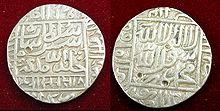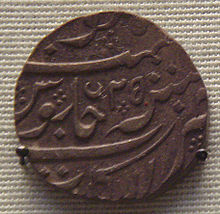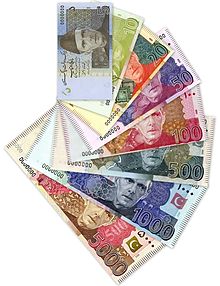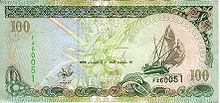
Rupee
About this schools Wikipedia selection
SOS Children made this Wikipedia selection alongside other schools resources. See http://www.soschildren.org/sponsor-a-child to find out about child sponsorship.
This article is about the currency used in various countries in Asia.
The rupee is the common name for the currencies of India, Pakistan, Sri Lanka, Nepal, Mauritius, Seychelles, Maldives (as the rupiah), and formerly those of Burma and Afghanistan. Historically, the first currency called "rupee" was introduced in the 16th century by Sher Shah Suri, founder of the Sur Empire of Northern India. The term is from rūpya, a Sanskrit term for silver coin, from Sanskrit rūpá, beautiful form.
In the Maldives, the unit of currency is known as the rufiyah, which is a cognate of the Hindi rupiya. Both the Indian rupees (![]() ) and the Pakistani rupee are subdivided into one hundred paise (singular paisa) or pice. The Mauritian and Sri Lankan rupees subdivide into 100 cents. The Nepalese rupee subdivides into one hundred paisas (both singular and plural) or four sukas or two mohors.
) and the Pakistani rupee are subdivided into one hundred paise (singular paisa) or pice. The Mauritian and Sri Lankan rupees subdivide into 100 cents. The Nepalese rupee subdivides into one hundred paisas (both singular and plural) or four sukas or two mohors.
Afghanistan's currency was also denominated in Afghan rupees until 1925, with each Afghan rupee subdividing into 60 paisas. Prior to the introduction of the Afghan rupee in 1891, the legal currency was the Kabuli rupee. Until the middle of the 20th century, Tibet's official currency was also known as the Tibetan rupee. The Indian rupee was the official currency of Dubai and Qatar until 1959, when India created a new Gulf rupee (also known as the "external rupee") to hinder the smuggling of gold. The Gulf rupee was legal tender until 1966, when India significantly devalued the Indian rupee and a new Qatar-Dubai Riyal was established to provide economic stability.
Alternative names and pronunciations
"Rupee" is abbreviated as Re. (singular), Rs. (plural), and ₹ ( Indian rupee symbol) in the case of the Indian rupee, a combination of the Devanagari letter र ( ra) and the Roman capital letter R.
Various languages render the word 'rupee' slightly differently:
- Sinhala: රුපියල් rupiyal
- Assamese: টকা ṭakā
- Bengali: টাকা ṭākā
- Maithili: টকা ṭakaā
- Dhivehi: ރުފިޔާ rufiyā
- Farsi: روپیه
- Gujarati: રૂપિયો rupiyo
- French: roupie
- Hindustani: रुपया روپیہ rupiyā
- Hungarian: rúpia
- Kannada: ರೂಪಾಯಿ rūpāyi
- Malayalam: രൂപ rūpa
- Marathi: रुपया rupayā
- Nepali: रुपैया rupaiyā
- Oriya: ଟଙ୍କା ṭaṁkā
- Pashto: روپۍ rupëi
- Portuguese: rupia
- Punjabi: ਰੁਪਈਆ rupīā
- Spanish: rupia
- Sanskrit: रूप्यकम् rūpyakam
- Tamil: ரூபாய் rūbāy derived from உருப்பு uruppu
- Telugu: రూపాయి rūpāyi
- Turkish: Rupi
Etymology
The Hindustani (Hindi-Urdu) word rūpiya is derived form Sanskrit word rūpya, which means "wrought silver, a coin of silver", in origin an adjective meaning "shapely", with a more specific meaning of "stamped, impressed", whence "coin". It is derived from the noun rūpa "shape, likeness, image". The word rūpa is being further identified as having sprung from the Dravidian (proto-Tamil) root uruppu, which means "a member of the body".
Rūpya was used as a generic descriptor or a common noun for silver coins of any denomination at least since the Magadha kingdom. Rūpiya was adopted as the name of a silver coin weighing 178 grains minted in northern India by Pashtun (Afghan) Emperor Sher Shah Suri during his brief rule between 1540 and 1545. Suri also introduced copper coins called dam and gold coins called mohur that weighed 169 grains. Later Mughal Emperors also standardised this coinage of tri-metalism across the subcontinent to consolidate the monetary system.
Value
The derivative word rūpaya was used to denote the coin introduced by Sher Shah Suri during his reign from 1540 to 1545. The original rūpaya was a silver coin weighing 178 grains (11.534 grams). The coin has been used since then, even during the times of British India, defined as 11.66g of .917% silver with an ASW of .3437 of a Troy ounce (that is, silver worth about US$10 at modern prices). At the end of the 19th century, the Indian silver rupee went unto a gold exchange standard at a fixed rate of one rupee to one shilling and fourpence in British currency, or 15 rupees to 1 pound sterling.
Valuation of the rupee based on its silver content had severe consequences in the 19th century, when the strongest economies in the world were on the gold standard. The discovery of vast quantities of silver in the United States and various European colonies resulted in a decline in the relative value of silver to gold.
Denomination
Formerly, the rupee (11.66 g, .917 fine silver) was divided into 16 annas, 64 paise, or 192 pies.
Each circulating coin of British India and later India and Pakistan, until the rupee was decimalised, had a different name in practice. A paisa was equal to two dhelas, three pies and six damarees. While a coin was minted for pie after independence in Pakistan for a very short period, a dhela and a damaree were never minted. Other coins for two paisas (taka), two annas (dawannee), four annas (a chawanee, or a quarter of a rupee), eight annas (an atthannee, or half a rupee) were widely in use until decimalization in 1961.The names of these coins denotes the numeral of their value in annas in Urdu except taka (two paisas or half an anna). While the word taka was commonly used in East Pakistan (now Bangladesh), alternatively for rupee, the two paise coin was called a taka in West Pakistan. Taka is an ancient Sanskrit word for money. After the partition of India, these coins remained in circulation until decimalization in 1961 in Pakistan. As the value of rupee rapidly eroded over the years, minting of the fractions of decimalized rupee has been completely abandoned. Presently, bank notes and some coins of 5 and 10 rupees are rarely in use and the paper currency is the sole method of any cash transaction. All fractions of the rupee are of only historical significance and no fractions are in use at all. It is, however, interesting that a taka in West Pakistan was worth two paises while this word was used alternatively for rupee in East Pakistan. After its independence, Bangladesh started to officially call its currency "taka" (BDT) in 1971.
Early 19th-century East India Company rupees were used in Australia for a limited period. Decimalisation occurred in Ceylon (Sri Lanka) in 1969, in India in 1957, and in Pakistan in 1961. Thus, an Indian rupee is now divided into 100 paise and so is the Pakistani rupee. Paisa is sometimes referred to as naya-paisa, meaning the "new-money" in India, a habit continued from when India became independent—when the new country introduced new currency, people used naya-paisa to distinguish it from the old currency. The issuance of the currency is controlled by the Reserve Bank of India, whereas in the Pakistan, it is controlled by State Bank of Pakistan. The most commonly used symbol for the rupee is "Rs". India adopted a new symbol (![]() ) for Indian rupees on 15 July 2010.
) for Indian rupees on 15 July 2010.
In most parts of India, the rupee is known as rupaya, rupaye, or one of other terms derived from the Sanskrit rupya, meaning silver. However, in the Bengali and Assamese languages, spoken in Assam, Tripura, and West Bengal, the rupee is known as a taka, and is written as such on Indian banknotes. In India and Pakistan, currency is issued in denominations of 1, 2, 5, 10, 20, 50, 100, 500 and 1000 rupees. Pakistan currency is also issued in a denomination of 5000 rupees. Large denominations of rupees are often counted in lakh (100,000 = 1 lakh, 100 lakh = 1 crore/karor, 100 crore/karor = 1 Arab, 100 Arab = 1 kharab/khrab, 100 Kharab/khrab = 1 Neel, 100 Neel = 1 Padma, 100 Padma = 1 Shankh, 100 shankh = 1 udpadha, 100 udpadha= 1 ank). Terms beyond a crore are not generally used in the context of money, e.g. an amount would be called Rs 1 lakh crore (equivalent to 1 trillion) instead of Rs 10 kharab.
East African Coast and South Arabia
In East Africa, Arabia, and Mesopotamia, the rupee and its subsidiary coinage was current at various times. The usage of the rupee in East Africa extended from Somalia in the north, to as far south as Natal. In Mozambique, the British India rupees were overstamped, and in Kenya, the British East Africa Company minted the rupee and its fractions, as well as pice. The rise in the price of silver immediately after the first world war caused the rupee to rise in value to two shillings sterling. In 1920 in British East Africa, the opportunity was then taken to introduce a new florin coin, hence bringing the currency into line with sterling. Shortly after that, the florin was split into two East African shillings. This assimilation to sterling did not, however, happen in British India itself. In Somalia, the Italian colonial authority minted 'rupia' to exactly the same standard, and called the pice 'besa'.
Straits Settlements
The Straits Settlements were originally an outlier of the British East India Company. The Spanish dollar had already taken hold in the Straits Settlements by the time the British arrived in the 19th century; however, the East India Company tried to introduce the rupee in its place. These attempts were resisted by the locals, and by 1867 when the British government took over direct control of the Straits Settlements from the East India Company, attempts to introduce the rupee were finally abandoned.
Sign
It is common to find a prefix before the digits denoting the rupee currency value written as "Re: 1" (for one unit), or "Rs. 140" (for more than one rupee).
Indian rupee sign

The Indian rupee is represented by the Indian rupee sign, ₹. The new sign is a combination of the Devanagari letter र ( ra) and the Latin capital letter R without its vertical bar (similar to the R rotunda). The parallel lines at the top (with white space between them) are said to make an allusion to the tricolor Indian flag. and also depict an equality sign that symbolizes the nation's desire to reduce economic disparity.
Origin
On 5 March 2009, the Indian government announced a contest to create a sign for the Indian rupee. During the 2010 Union Budget, Finance Minister Pranab Mukherjee mentioned that the proposed sign would reflect and capture the Indian ethos and culture. Five signs created by Nondita Correa-Mehrotra, Hitesh Padmashali, Shibin KK, Shahrukh J Irani, and D Udaya Kumar had been short-listed from around 3,331 responses received and one of them was to be finalized at the Union Council of Ministers of India meeting held on 24 June 2010. The decision was deferred by a request of the Finance Minister, and it was decided when they met again on 15 July 2010, and selected the symbol created by D.Udaya Kumar son of N. Dharmalingam, a former DMK MLA.
Controversy
The selection process was challenged under the Right to Information Act in the Delhi High Court. The petitioner, Rakesh Kumar, who was a participant in the competition, described the process as "full of discrepancies" and "flawed", and named the Finance Ministry and the chairman of Indian Rupee Symbol Selection Committee as respondents.
On 26 November 2010, the Delhi High single bench Court dismissed the writ petition, stating there was no justifiable ground for the stated allegations. On 31 March 2011 High Court double bench of Chief Justice and Justice Sanjiv Khanna of Delhi High Court in their judgment court allowed RTI activist Rakesh Kumar Singh to file PIL against “ Indian Rupee symbol selection process”.
On 25 April 2012 Delhi High court issued notice to government of India over rupee and other symbols selection process. On 11 July 2012 in court hearing Government of India did not respond to the serious charges made in PIL. After that Hon'ble Delhi High Court slams MHA for failing to respond and asked government to respond with in four weeks, in next hearing on 22 August 2012.
In its 3 October 2012 order, the High Court said "last opportunity is granted to the respondent to file the counter affidavit. Let the same be filed within six weeks]."
On 5 December 2012, the Delhi High Court issued notice to the Indian government as it was not responding to the serious charges made in PIL.
On 3 January 2013 taking cognizance in view of the irregularities, flawed and arbitrariness involved in Rupee symbol and other Public Competitions, Hon'ble Delhi High Court in its landmark judgement directed Indian government to formulate/prepare guidelines to ensure transparency, wider participation of public in Public Competitions.
Fictional use
The rupee is the name of the currency used in the Legend of Zelda and Rappelz video games.
In Super Paper Mario, Mario, the protagonist, collects rupees (called 'rubees') in Chapter 2.
Famously referred to by Miss Prism in Oscar Wilde's The Importance of Being Earnest : "Cecily, you will read your Political Economy in my absence. The chapter on the Fall of the Rupee you may omit. It is somewhat too sensational. Even these metallic problems have their melodramatic side."






